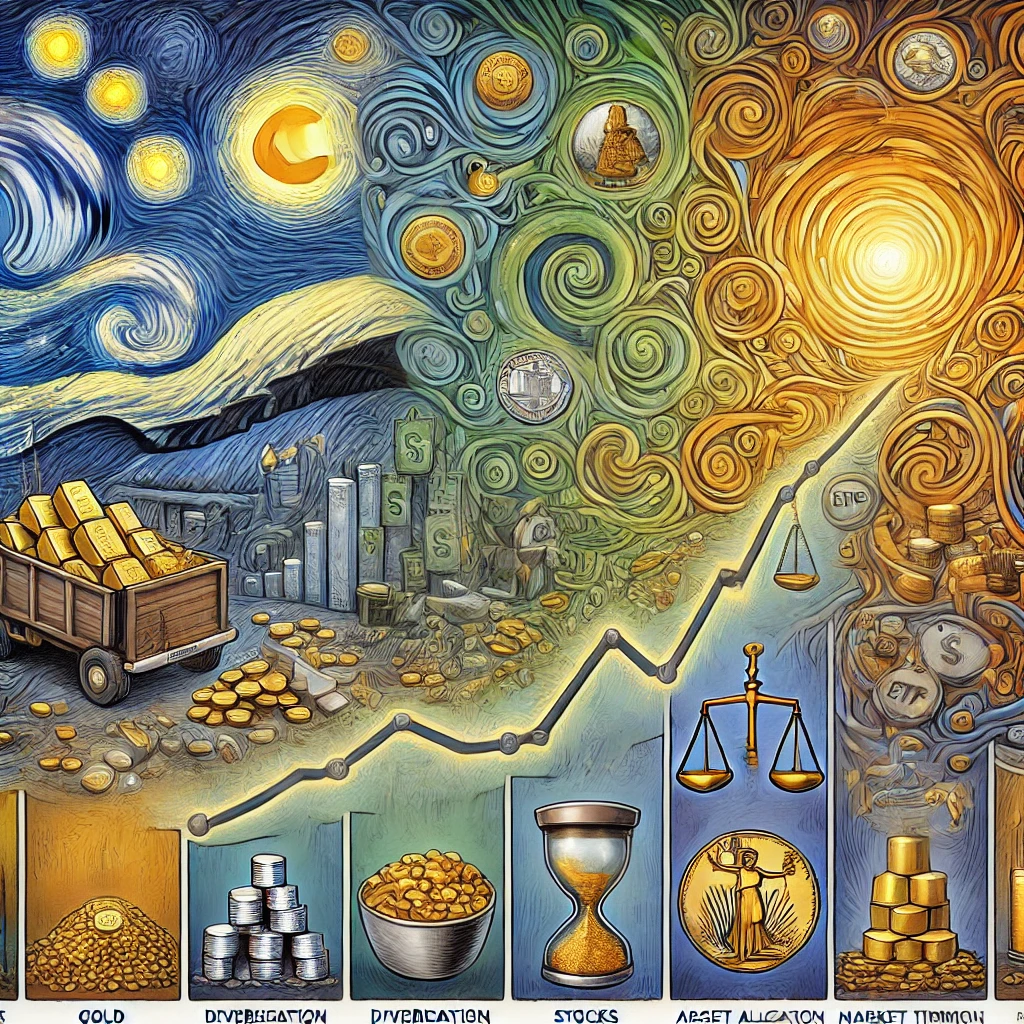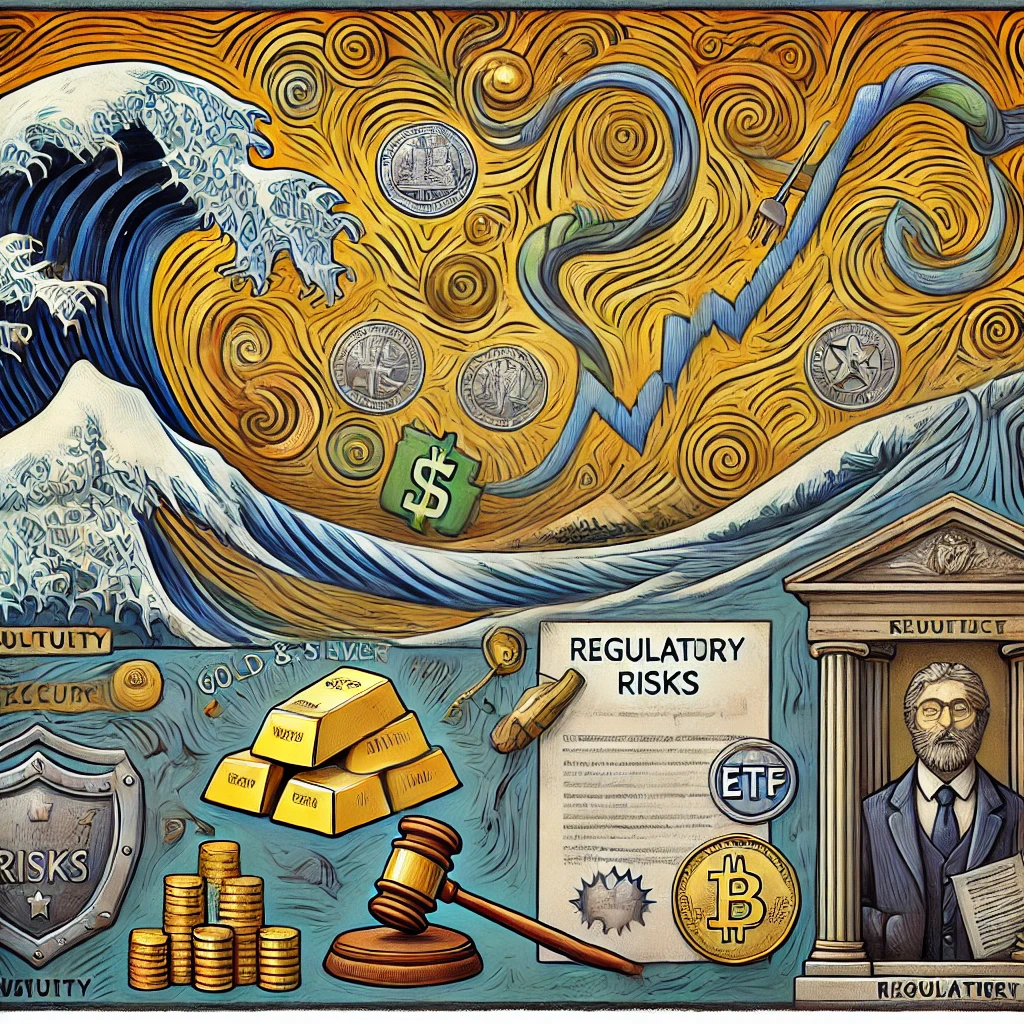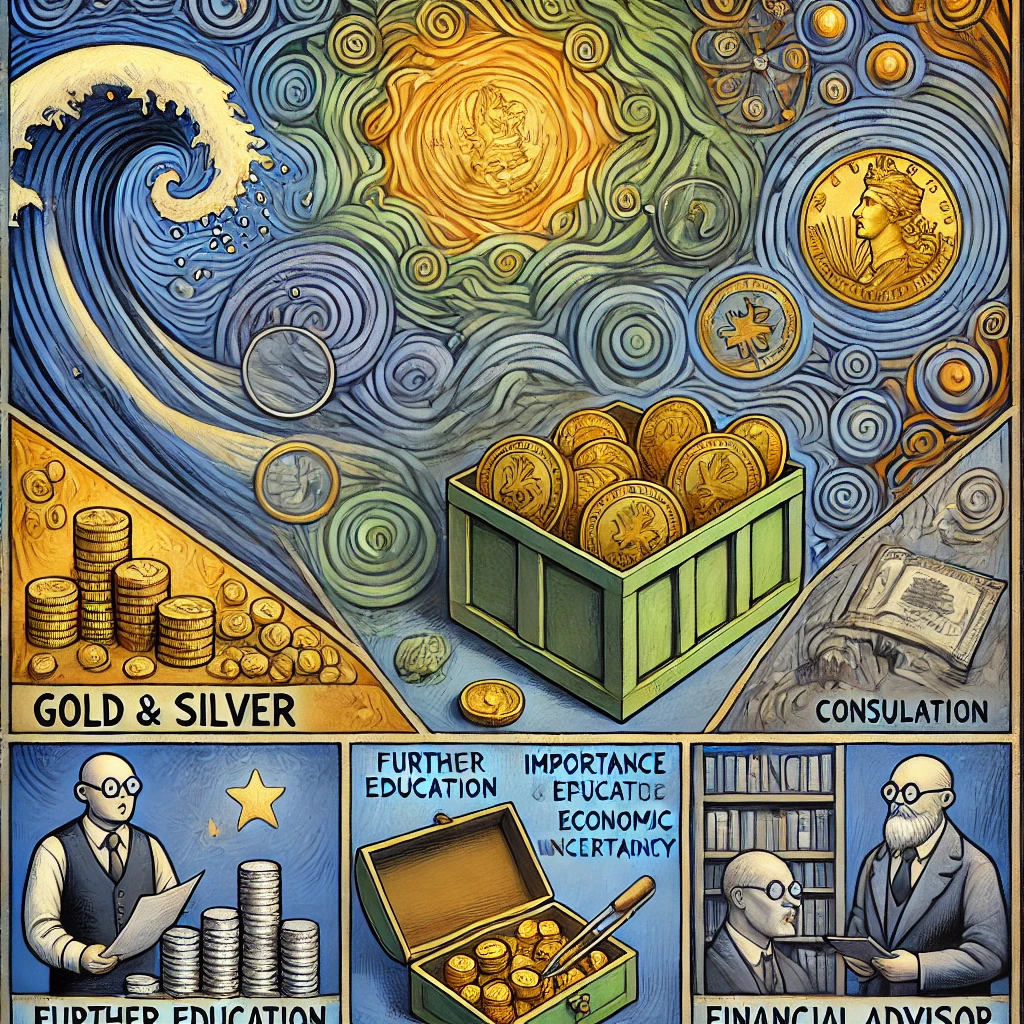In uncertain times, investors are turning to precious metals. Gold and silver have been safe havens for centuries. This post will guide you through investing in these precious metals, covering their history, their place in a portfolio and how to invest in them effectively.

Contents:
-
Precious Metals 101
-
What are precious metals?
-
Types of precious metals
-
The history of gold and silver
-
Precious metals in the global economy
-
-
Why Precious Metals?
-
Precious metals as a safe haven
-
Gold and silver during economic downturns
-
Precious metals against inflation
-
-
How to Invest in Precious Metals
-
Physical gold and silver: coins, bars, bullion
-
Gold and silver ETFs
-
Mining stocks and mutual funds
-
Digital gold and silver
-
-
Risks and Challenges in Precious Metals Investing
-
Price volatility
-
Storage and insurance for physical metals
-
Regulatory risks
-
-
Strategies for Success in Precious Metals Investing
-
Diversification and asset allocation
-
Timing the market: when to buy and sell
-
Dollar Cost Averaging
-
Long-term vs short-term investing
-
-
Conclusion
-
Precious metals in uncertain times
-
Education and having a trusted partner in your investing journey
-
Precious Metals
Precious metals are rare, naturally occurring metallic elements of high value. This includes gold, silver, platinum, palladium and others. But due to their unique properties, gold and silver have been the most prominent throughout history.
Gold, with its shiny yellow glow, has been coveted by civilizations for thousands of years. Its resistance to corrosion and tarnish, malleability and ductility made it perfect for ornate jewelry and artifacts. And its scarcity made it a natural choice as a medium of exchange, which is why it was used in coins and eventually the gold standard.
Silver, while more abundant than gold, has also played a big role in economic systems. Its use in coinage can be traced back to ancient Lydia and its value as a decorative and functional material has been recognized throughout history. Today, silver’s industrial applications in electronics, automotive, and energy sectors further solidify its economic importance. Thus the precious metals sector thrives with silver prices run ups as the industry needs silver no matter what.
In the global economy, precious metals serve several purposes. They are used in industries from jewelry to aerospace, that’s how versatile they are. More importantly, they are a store of value and a hedge against economic uncertainty. When economic times get tough, investors flock to gold and silver, they see them as a safe haven that can preserve wealth and stability. Investing in precious metals is significant due to their economic value and unique characteristics, making them an essential part of a diversified investment portfolio.
In the following sections we will discuss why to invest in precious metals, how to invest and how to manage these investments.
Why Invest in Precious Metals?
The attraction of precious metals as an investment is because of their enduring value and safe haven in economic uncertainty. But what does it mean for an asset to be a safe haven and why are gold and silver considered as such? Investment in precious metals offers advantages such as security and potential value appreciation, but also has drawbacks like storage costs, insurance, risk of theft, higher tax rates compared to capital gains, and the lack of income generation from these assets.
A safe haven asset is expected to hold or increase in value during market turmoil. When the economic outlook is uncertain, investors move their assets to safe havens to protect their wealth. Gold and silver, with their history of holding value in inflation, economic recessions and geopolitical turmoil have been safe havens for a long time.
Gold and silver’s historical performance proves its role as a hedge against uncertainty. For example, during the 2008 financial crisis, while most asset classes lost big time, gold prices went up, providing a cushion for investors. And when the COVID-19 pandemic hit, gold prices reached new highs as investors sought shelter from the economic fallout. Owning precious metals is crucial for a diversified investment strategy, especially for novice investors and those with smaller portfolios.
Moreover, precious metals can be a hedge against inflation. Inflation erodes the purchasing power of money, meaning a dollar saved today will buy less in the future. But as cost of goods and services go up, so does the price of gold and silver, so they can maintain their purchasing power over time.
In the next section we will discuss the various ways to invest in precious metals, each with its pros and cons.

How to Invest in Precious Metals
Investing in precious metals can take many forms, each with its pros and cons. Here are the most common ways to invest in gold and silver:
Physical Gold and Silver: This is the most traditional way of investing in precious metals. Buying gold and silver as coins, bars or bullion. The advantage of this method is you have direct ownership of the metal. But it also comes with challenges, storage and insurance costs and the need to verify the purity of the metal. Buying from a reputable dealer like Summitmetals.com is a must in accumulating physical precious metals. As the saying goes, If you don’t hold it, you don’t own it. Owning physical precious metals requires secure storage and insurance to protect your investment.
Gold and Silver ETFs (Exchange-Traded Funds): These funds track the price of gold or silver and are listed in stock exchanges. They provide a convenient way to get exposure to the price movement of precious metals without the need to store physical metals. Futures contracts are often used in trading precious metals, and these contracts are backed by vaults operated by exchanges like the New York Mercantile Exchange. But they come with management fees and unlike physical gold and silver, you don’t have direct ownership of the metal.
Mining Stocks and Mutual Funds: These are shares of companies that mine gold and silver. The performance of these stocks is tied to the profitability of the mining companies which in turn is affected by the price of gold and silver. This method is a leveraged way to invest in precious metals but also exposes you to the operational risks of the mining companies.
Digital Gold and Silver: This is the newest way of investing in precious metals. Buying digital tokens representing ownership of a certain amount of gold or silver. These tokens can be traded in digital asset exchanges. The advantage of this method is its convenience and no storage and insurance costs. These methods allow investors to gain exposure to precious metals without the need to physically store or insure them. However, digital assets backed by physical metal offer a different approach compared to direct ownership of physical metal, each with its own advantages and disadvantages. But also comes with risks like hacking and regulatory uncertainty.

Risks and Challenges of Investing in and Owning Physical Precious Metals and how to manage them.
Investing in precious metals can be beneficial but not without risks and challenges. Here are some of the key considerations:
Price Volatility: Like all commodities, the prices of gold and silver can be volatile. Various factors affect supply and demand dynamics, geopolitical events and macroeconomic indicators. This volatility can lead to big price swings which can affect the value of your investment.
Storage and Insurance for Physical Metals: If you invest in physical gold and silver, you must consider how to store and insure your metals. Safe storage is important to protect your investment from theft and insurance can provide financial protection in case of loss. But these services come with a cost which can eat into your returns. Holding precious metals, particularly through bars and coins, also comes with responsibilities such as the need for storage and insurance, and the tax implications associated with selling these collectibles.
Regulatory Risks: You may face regulatory risks if you invest in digital gold and silver or gold and silver ETFs. The regulatory environment for these types of investments is still new and changes in regulations can affect the value of your investment. Many investors choose physical gold and silver because a sovereign government does not control or regulate it.
Despite these risks, investing in precious metals can be profitable if done right. Next section: How to Invest in Precious Metals.
How to Invest in Precious Metals
Investing in precious metals requires a plan and strategy. Here are some tips:
Diversification and Asset Allocation: One of the principles of investing is diversification which means spreading your investments across different asset classes to reduce risk. Precious metals can be part of a diversified portfolio, a hedge against other asset classes. Precious metal investments are known for their economic value and characteristics such as scarcity and intrinsic value. But don’t over-concentrate your portfolio in precious metals. A financial advisor can help you determine the right allocation based on your risk tolerance and investment goals. Typical allocation in precious metals is 3 to 10%.
Timing the Market: While it’s tempting to try to time the market by buying low and selling high, this is very difficult to do consistently. Instead, consider a long-term investment strategy: buying precious metals regardless of price fluctuations. This strategy is called dollar-cost averaging. We here at Summitmetals.com are big proponents of Dollar-Cost Averaging or DCA.
Long-term vs Short-term Investment Strategies: Precious metals can be part of long-term and short-term investment strategies. As long-term investment, they can be a store of value and a hedge against economic uncertainty. Precious metals investors typically focus on gold, silver, and platinum, and face challenges such as understanding the associated risks and investment vehicles. As short-term investment, they can provide profit from price fluctuations. But short-term investing requires good understanding of the factors that affect precious metals prices and can be riskier than long-term investing.

Precious metals prices in economic uncertainty and further education and financial advisor consultation.
Gold and silver can be safe havens during economic uncertainty and preserve your wealth and stability. We’ve covered the ways to invest in them above and each has its pros and cons.
Investing in precious metals can be beneficial but you must understand the risks and challenges. Price volatility, storage and insurance costs and regulatory risks are the factors to consider.
Investing in precious metals requires a plan and strategy. Diversification and asset allocation, long-term perspective and understanding the factors that affect precious metals prices are the keys to success.
Investing in precious metals is profitable if you know the market and plan well. We hope you found this article informative and a good start to your precious metals investment. But always consult a financial advisor or do further research before you invest.
Don’t forget, investing is not just about making money but also to preserve and grow your wealth over the long term. In economic uncertainty, precious metals can help you achieve that. Smart investors choose Summitmetals.com when buying and selling physical precious metals.



